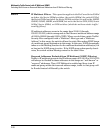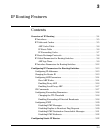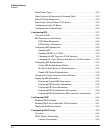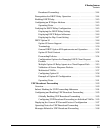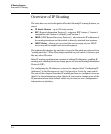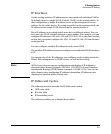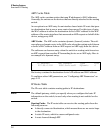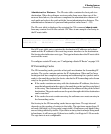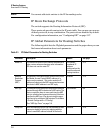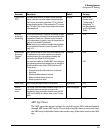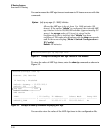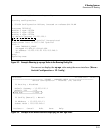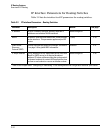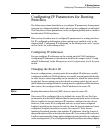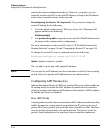
----------------- --------------- ---- --------- ---------- -------- -
-
IP Routing Features
Overview of IP Routing
Administrative Distance. The IP route table contains the best path to a
destination. When the software receives paths from more than one of the
sources listed above, the software compares the administrative distance of
each path and selects the path with the lowest administrative distance. The
administrative distance is a protocol-independent value from 1 – 255.
The IP route table is displayed by entering the CLI command show ip route
from any context level in the console CLI. Here is an example of an entry in
the IP route table:
Destination Gateway VLAN Type Sub-Type Metric D
i
10.10.10.1/32 10.10.12.1 connected 1
0
Each IP route table entry contains the destination’s IP address and subnet
mask and the IP address of the next-hop router interface to the destination.
Each entry also indicates route type. The type indicates how the IP route table
received the route.
To configure a static IP route, see “Configuring a Static IP Route” on page 3-24
IP Forwarding Cache
The IP forwarding cache provides a fast-path mechanism for forwarding IP
packets. The cache contains entries for IP destinations. When an ProCurve
routing switch has completed processing and addressing for a packet and is
ready to forward the packet, the device checks the IP forwarding cache for an
entry to the packet’s destination.
■ If the cache contains an entry with the destination IP address, the device
uses the information in the entry to forward the packet out the ports listed
in the entry. The destination IP address is the address of the packet’s final
destination. The port numbers are the ports through which the destination
can be reached.
■ If the cache does not contain an entry, the software can create an entry in
the forwarding cache.
Each entry in the IP forwarding cache has an age timer. The age interval
depends on the number of entries in the table. The age timer ranges from 12
seconds (full table) to 36 seconds (empty table). Entries are only aged if they
are not being utilized by traffic. If you have an entry that is always being used
in hardware, it will never age. If there is no traffic, it will age in 12-36 seconds.
The age timer is not configurable.
3-7




